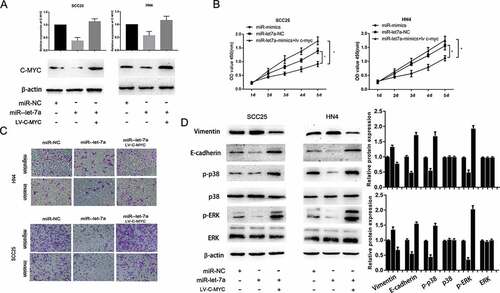Figures & data
Figure 1. Down-regulated expression of miR-let-7a in OSCC tissues and OSCC cell lines. (a) The relative expression of miR-let-7a in 60 paired OSCC tissues and adjacent normal tissues were detected by miRNA RT-PCR. (b) Expression of miR-let-7a in OSCC cell lines and the human normal oral keratinocytes (HOK) cell line were detected by miRNA RT-PCR. (*P < 0.05, **P < 0.01, ***P < 0.001) (c, d) Overall survival and progression-free survival curves were compared between OSCC patients with low expression level of miR-let-7a and those with high level of miR-let-7a. All assays in this part were performed in triplicates.
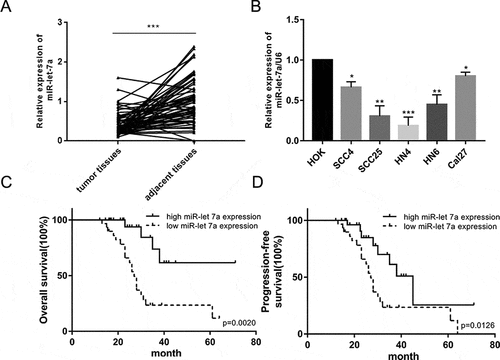
Table 1. Correlation between clinical pathologic features and the miR-let-7a and c-myc expressions in patients with oral squamous cell carcinoma.
Figure 2. Effects of miR-let-7a on proliferation, migration and invasion of OSCC in vitro. (a, b) MiRNA RT-PCR was used to confirm the expression of miR-let-7a in cells transfected with miR-let-7a-mimics and miR-let-7a-inhibitor. (c) CCK-8 was were used to evaluate the proliferation of in Cal 27, HN4 and HCC-25 cells after transfection with the miR-let-7a inhibitor, miR-let-7a mimics or negative control. (d) Transwell assay was performed to detect the ability of migration and invasion of miR-let-7a inhibitor, miR-let-7a mimics transfected Cal 27, HN4 and HCC-25 cells and their negative control. (e) Quantification of Transwell assay (*P < 0.05, **P < 0.01, ***P < 0.001). All assays in this part were performed in triplicates.
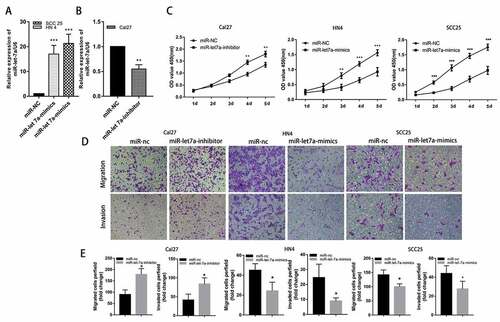
Figure 3. Overexpression of miR-let-7a inhibits OSCC in vivo. (a) Photographs of tumors obtained from the different groups of nude mice transfected with miR-let-7a mimics and miR-NC. (b) Tumor growth curve of nude mice transfected with miR-let-7a-mimics and miR-NC, Tumor diameters were measured every 7 d. (c) The weight of the tumor tissues of nude mice transfected with miR-let-7a-mimics and miR-NC D miR-let-7a expression levels were detected in tumor tissues from miR-let-7a-mimics and miR-NC groups. All assays in this part were performed in triplicates.
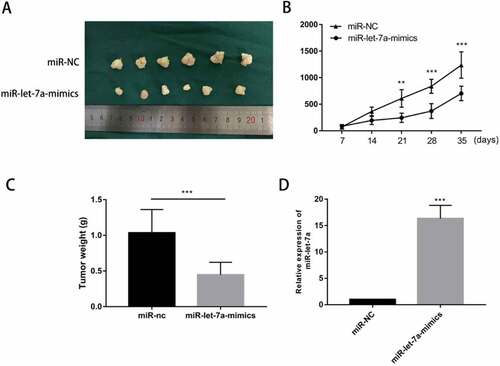
Figure 4. c-Myc is a direct target of miR-let-7a in OSCC cell lines. (a) miR-let-7a and its putative binding sequence in the wild-type and mutant 3′-UTR of c-Myc, Overexpression of miR-let-7a significantly decreased the luciferase activity that carried wild type (WT) but not mutant type (MUT) 3′-UTR of c-Myc in HCC-25, HN4 cells. (b) Expression of c-Myc was upregulated in 60 paired OSCC tissues compared with adjacent normal tissues (c) c-Myc was negatively correlated with miR-let-7a. (d) Expression of c-Myc in HCC-25, HN4 cells transfected with miR-let-7a-mimics or miR-NC was detected by qRT-PCR and western blot, Overexpression of miR-let-7a markedly suppressed the mRNA and protein levels of c-Myc in HCC-25, HN4 cells. (e) The correlation between miR-let-7a/c-Myc co-expression and the percentage of metastatic lymph nodes. (f) Overall survival of OSCC patients. Patient groups were separated based on expression status of miR-let-7a and c-Myc. All assays in this part were performed in triplicates.
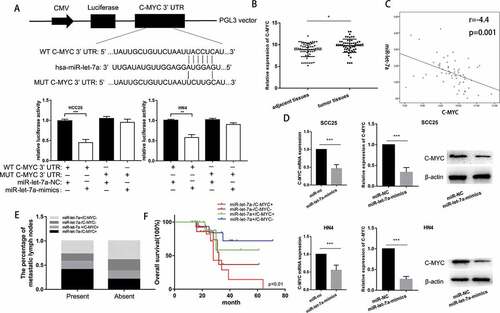
Figure 5. Overexpression of miR-let-7a inhibits proliferation, migration and invasion and regulates MAPK/ERK signaling pathway by targeting c-Myc. (a) qRT-PCR and Western blot analysis showed that over expression of miR-let-7a reduced the c-Myc RNA and protein expression, while co-transfection of c-Myc overexpression plasmids could recover the c-Myc RNA and protein expression. (b, c) Co-transfection of c-Myc plasmid reverted the suppressive effects of miR-let-7a overexpression on the proliferation, migration and invasion. (d) The expression of MAPK/ERK signaling was evaluated by western blot, miR-let-7a overexpression could notably down-regulate the expression of phosphorylated p38 and ERK, while the total amount of p38 and ERK showed no differences. Overexpressed c-Myc could partially counteracted the change of the expression of phosphorylated p38 and ERK. All assays in this part were performed in triplicates.
